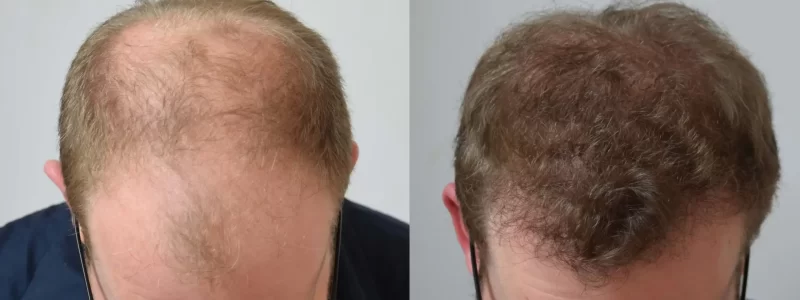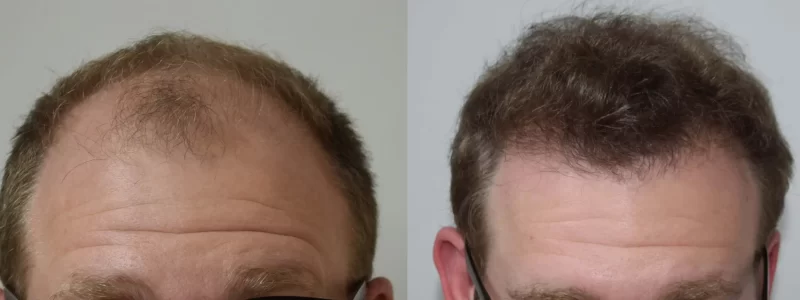Restore your confidence with FUT hair transplant
Physician's Hair Institute Scottsdale & Tucson, Arizona offers FUT hair transplants to restore a thicker, fuller head of hair.
What is Follicular Unit Transplantation Hair Transplant (FUT)?
Hair loss can be caused by a lot of things, but here are the most common ones:
- Androgenetic alopecia (Male/female pattern hair loss): This is the most common type of hair loss, affecting both men and women. It is caused by genetics and hormones. In men, it typically presents as a receding hairline and hair loss at the crown of the head. In women, it usually causes thinning hair all over the scalp.
- Telogen effluvium: This is a temporary hair loss condition that is caused by a disruption in the hair growth cycle. It can be triggered by stress, illness, childbirth, surgery, or a sudden change in weight. Telogen effluvium usually results in a general thinning of hair all over the scalp.
- Alopecia areata: This is an autoimmune disease that causes the immune system to attack the hair follicles. It can cause hair to fall out in round or oval patches, anywhere on the body, including the scalp, beard, eyebrows, and eyelashes.
- Traction alopecia: This type of hair loss is caused by pulling or tension on the hair. It can be caused by hairstyles that pull on the hair, such as tight braids, cornrows, or ponytails. Traction alopecia can also be caused by wearing hair extensions or weaves.
FUT Procedure
Who is Eligible for FUT?
- Have noticeable hair loss patterns, such as a receding hairline or thinning at the crown
- Adequate supply of healthy donor hair on the back or sides of the head
- In good health to ensure proper healing and hair growth post-transplant
- Have realistic expectations
- Best suited for those without extremely loose or tight scalp skin
Who is Eligible for FUT?
- Individuals with advanced pattern hair loss or significant thinning who haven’t benefited from other treatments.
- Those who plan to wear their hair long, as the scar can be concealed.
- Patients who prefer a one-time extensive session for considerable hair density improvement.
- Those who wish to minimize the number of treatment and recovery sessions may also prefer FUT.
What You Should Expect Before and During the FUT Procedure?
How Much is the FUT Procedure?
The cost of FUT hair transplant will vary depending on your location, how skilled and well-known your surgeon is, the extent of your hair loss, and how many hair grafts you’ll need. There might be extra costs like consultations with the doctor before and after the surgery, and any follow-up visit needed later.
Make sure you know what’s included in the quoted price so you don’t get surprised by extra charges. At the Physician’s Hair Institute, we provide a detailed breakdown of the costs for you when you first talk to us so you know what you’re paying for. It’s good to think about the quality of the results and the surgeon’s expertise, not just the price when deciding where to get your FUT transplant.
Frequently Asked Questions About FUT
How long does the FUT procedure take?
Is the FUT result permanent?
How long does the FUT recovery take?
What is the difference between FUT and FUE?
FUT involves removing a strip of scalp from the back or sides of the head and harvesting the follicular units and transplanting them to the recipient area. This leaves a linear scar in the donor area, but can be easily hidden by the surrounding hair.
On the other hand, FUE involves extracting individual hair follicles directly from the scalp. This technique offers minimal scarring compared to FUT, but it still leaves ‘dot-like’ scars. However, FUE requires the head to be shaved short so those who like to wear their hair long may not prefer this option.
Are there any side effects associated with FUT hair transplants?
Is FUT a minimally invasive hair transplant procedure?
FUT is considered more invasive than FUE due to the strip extraction method, which involves a surgical incision and results in a linear scar. The recovery involves healing of this incision site, which can take more time and care compared to the puncture wounds from FUE.
However, FUT allows surgeons to harvest a much larger number of hair grafts than FUE. It’s often the option for patients who have extensive hair loss and require a large number of grafts.
WHAT CAN I EXPECT AFTER MY PROCEDURE?
After the treatment, an ointment will be applied to the skin and you will be asked to refrain from wearing make up for several hours. Any minor redness or swelling resulting from treatment will subside within 12-24 hours. After the treatment, you can expect to retum to normal activities.


